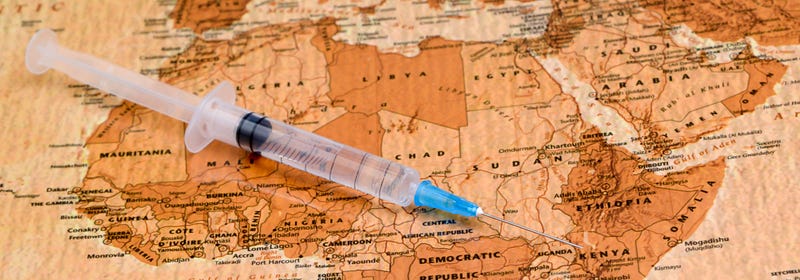Changes to Vaccine Contracts Could Save Lives Worldwide
By retooling the way vaccines are paid for, health organizations could incentivize pharmaceutical companies to get more doses to poorer countries.
Based on the research of Diwakar Gupta

In unprecedented, record-shattering time, the pharmaceutical industry has created, tested, and won regulatory approvals for multiple vaccines to prevent COVID-19. Now, another mammoth task lies ahead: vaccinating the world.
Not just the industrialized world, but countries that can’t afford the U.S. cost of $20 per dose.
New research by Diwakar Gupta, professor of information, risk, and operations management at Texas McCombs, might give that mission a shot in the arm. It finds that by changing the design of vaccine procurement contracts, international agencies could entice manufacturers to produce more shots for developing nations — at no extra cost beyond the allotted budget.
Testing his model on an existing pneumococcal vaccine, Gupta found the alternate design could produce almost 600,000 more doses than existing contracts over 10 years. Because the vaccine requires three shots, that would be enough to immunize 200,000 more infants.
Could such a contract help to get more vaccines for COVID-19 to needy nations? Gupta hopes it might. “You cannot prevent the spread unless sufficient numbers of people worldwide are vaccinated,” he says.
“How can you make sure that firms are committing the highest possible capacity to supplying doses?” — Diwakar Gupta
Subsidies for Shots
When Gupta first got interested in this subject, the COVID-19 pandemic was not on the horizon. He had analyzed other kinds of purchasing contracts in health care, and he saw an opportunity to apply the principles to vaccines.
He focused on the Global Alliance for Vaccines and Immunization (Gavi), which has immunized more than 760 million children worldwide. It raises money from donors like the Bill & Melinda Gates Foundation, and it negotiates production commitments from pharmaceutical companies. Once those commitments are made, each country decides how many doses to order.
But the lack of financial incentives for producers presents a major hurdle. A pneumococcal vaccine, which protects infants against diseases such as pneumonia and meningitis, sells in the U.S. for $143 a dose. Gavi’s contracts set the price for developing countries, which pay on a sliding scale based on their gross national income. A typical payment is a mere $2.90.
That’s barely enough for pharmaceutical companies to break even. So Gavi adds $3.50 to each of the first 20% of doses they sell. Says Gupta, “It encourages firms to invest in the capacity to supply the vaccines.” However, companies receive the subsidy only if there is demand for their product.
Since 2009, the contracts have brought pneumococcal vaccines to more than 225 million children. But Gupta wondered whether companies were manufacturing all that they could.
“It’s been a success story,” he says. “I wanted to see whether it could be even better.”
“Companies are willing to provide vaccines at cost, but it’s not clear how much they’ll prioritize them.” — Diwakar Gupta
Paying for What’s Not Produced
The problem, he explains, is uncertain demand. If countries don’t order as many doses as projected, a manufacturer gets stuck with idle capacity. To avoid that risk, a manufacturer doesn’t commit itself to produce the maximum possible number of doses.
In the retail field, buyback contracts solve that problem by compensating a producer for unused capacity. It gets partial payment from the retailer for units that don’t get sold, encouraging the producer to boost its commitment.
Could such a contract be used to increase vaccine supplies? With Karthik Natarajan of the University of Minnesota and McCombs graduate student Paola Martin, Gupta modeled three kinds of contracts: Gavi’s existing one and a variation, which subsidize only actual doses sold, and a hybrid contract, with one subsidy for sales and another for unused capacity.
For a Gavi budget of $225 million, the researchers found, all the contracts would produce about 300 million doses of pneumococcal vaccines over 10 years. But the hybrid contract had an edge. Compared with the existing one, it produced 589,980 more doses.
Although the difference might sound slight, Gupta says, “It could potentially save tens of thousands of lives.”
Contracts and COVID-19
Without enough vaccines for the coronavirus, even more lives are at stake. At present, says Gupta, the chief challenge is supply. But as pharmaceutical companies catch up with demand in the U.S. and Europe, they’ll turn to developing nations.
Gupta notes that Gavi is already negotiating with manufacturers, with the goal of reserving enough capacity for 1 billion vaccine doses by the end of 2021. Its initial goal is to raise $2 billion, providing shots in developing countries for no more than $2 a dose.
That’s probably just the beginning of a multiyear series of contracts, he says. “Immunity doesn’t seem to last long term. COVID vaccinations are likely to become a yearly problem, with annual cycles, like the flu.”
Gupta is collecting data to analyze those contracts, to see whether lessons from pneumococcal vaccines can carry over to COVID-19, and whether alternate contract designs can get more shots to the poorest countries.
“It’s going to be an interesting few months,” Gupta says. “Contracting issues are likely to be front and center.”
“Vaccine Procurement Contracts for Developing Countries” is published in Production and Operations Management, November 2020.
Story by Steve Brooks


